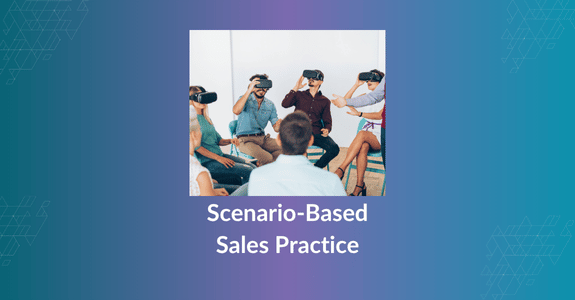Scenario-Based Sales Practice: When to Use It and How to Build It
by Mentor Group

Introduction
Reading about selling doesn’t change selling. Scenario‑based practice lets reps make mistakes safely, learn quickly and reach a consistent standard before important conversations. It’s efficient, scalable and grounded in your real customer moments.
For the foundations of a high‑quality training programme, see our pillar guide: What Should Good Sales Training Include?
What Is Scenario‑Based Sales Practice?
Short, structured simulations of common or high‑risk conversations—discovery, objections, pricing, executive updates—delivered digitally or live. Each scenario has a clear objective, a buyer context, and standards for what “good” looks like.
When to Use Scenario‑Based Practice
- Onboarding—standardise early wins and shorten time to confidence.
- New motions—product launches, pricing changes, new buyer personas.
- High‑stakes deals—C‑suite updates, late‑stage negotiations, risk reviews.
- Regulated or complex contexts—compliance‑sensitive conversations where clarity matters.
Anatomy of a Good Scenario
- Objective—what the rep must achieve (e.g., agree next step with date/owner).
- Context—buyer role, industry, current state and constraints.
- Prompts—what the buyer might say (including likely objections).
- Standards—plain‑English criteria for success (e.g., quantified impact, multithreading attempt).
- Feedback—specific “keep/change/try” notes with examples.
How to Build Scenarios Fast (Step‑by‑Step)
- Pick one behaviour to improve (discovery depth, objection handling, executive narrative).
- Draft a 120‑word brief (objective + context + two buyer prompts).
- Write 3–5 standards for success; avoid jargon and scoring complexity.
- Create a model answer (what “good” could sound like) to anchor feedback.
- Test with two reps and a manager; refine the brief and standards once.
- Release to a cohort with guidance on two or three re‑tries.
Designing Feedback that Changes Behaviour
- Instant and specific—reference the rep’s words where possible.
- Balanced—one thing to keep, one to change, one to try next time.
- Linked to standards—use the same language as your success criteria.
- Shareable—allow quick sharing of exemplars for manager coaching.
Live, Digital or Hybrid?
- Digital practice—on‑demand, repeatable and consistent; ideal for scaling basics.
- Live role‑play—great for nuance and team learning; use sparingly and record highlights.
- Hybrid—digital first, then a short live review to humanise the feedback and swap examples.
Implementation Plan (30–45 Days)
- Week 0–1: Select behaviours and define standards.
- Week 1–2: Build three scenarios with briefs, prompts and model answers.
- Week 2–4: Launch to a pilot cohort; encourage two or three re‑tries per scenario.
- Week 4–6: Review examples with managers; retire weak prompts and publish what to scale.
Governance, Privacy and Accessibility
- Use redacted or synthetic data in briefs and prompts; avoid customer PII.
- Clarify data location, retention and access for any recorded practice.
- Provide captions/transcripts and keyboard navigation to support all users.
Common Pitfalls (and Fixes)
- Overlong scenarios → keep to 3–5 minutes; depth comes from re‑tries, not runtime.
- Generic prompts → localise language to your buyers and sectors.
- Vague feedback → tie comments to standards and give an example phrase.
- Portal sprawl → integrate practice into CRM/Teams where possible.
Bottom Line
Q1. What is Scenario‑Based Sales Practice?
A1. Short, realistic simulations of customer conversations with clear objectives, prompts and success standards—so reps can rehearse safely and improve fast.
Q2. When should we use it?
A2. During onboarding, before high‑stakes calls, for new motions and in regulated or complex situations where accuracy matters.
Q3. How do we build good scenarios quickly?
A3. Pick one behaviour, draft a 120‑word brief, define 3–5 standards, craft a model answer, test once with users and release for two or three re‑tries.
Q4. Should we use digital or live role‑plays?
A4. Use digital for scale and consistency, then add short live reviews for nuance—hybrid delivers the best of both.
Q5. What does effective feedback look like?
A5. Instant, specific and tied to your standards—one thing to keep, one to change and one to try next time, with example phrasing.
Q6. How do we handle privacy and governance?
A6. Use redacted/synthetic data, define retention and access, and ensure accessibility with captions and transcripts.
Q7. How long should scenarios be?
A7. Keep to 3–5 minutes; encourage re‑tries for depth rather than long single takes.
Q8. How does this improve results?
A8. More reps, fewer surprises—leading to clearer discovery, better objection handling and smoother next steps in live opportunities.
